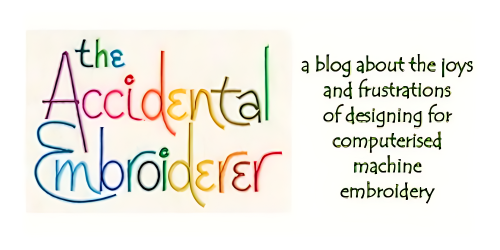A couple of weeks ago (on the 23rd of March) I posted the picture of a stitch-out of an aviary design inspired indirectly by one of my mother’s drawings. The embroidery consisted of small squares assembled into a small panel, and the whole panel was only about the size of an A4 piece of paper. Some of the individual squares were very small indeed – the smallest were only an inch square. I liked the aviary idea but began to be irritated by the smallness of the designs – there was no room to add intricate detailing to the individual birds, and I thought that such colourful birds deserved a little more thought and a little more detailing.
So I doubled the size of each bird and redigitised each one as an appliqué, and added a lot more detail to each one. As my machine is now repaired (thanks to the skill and kind attentions of Lubka, at David Drummond) I finally managed to stitch all the squares out, using my own painted fabric both for the background and the appliquéd birds. When it was assembled, the finished panel was about 28 inches tall, and certainly gave enough scope for intricate detailing on the individual birds.

The aviary panel, laid out but not yet stitched
But somehow it still didn’t work. It was decorative enough but it looked a bit flat and boring. The birds needed even more detail and more vitality So after some thought I started to use acrylic paints to add more character to each bird, and this did a lot to add to the interest of the whole thing. Each bird now has its own character and a lot more energy than the original plain appliquees. I’m still not finished with the painting, but here are some pictures of a couple of the birds before and after the over-painting.


Green and yellow birds, before and after over-painting
I have to admit that seen close-up, they do look a bit crude. However when they're all assembled into the final panel and seen from a few feet away, I think they'll do a lot better. You have to exaggerate some things to make them look better when seen from a distance.
Now I just have to finish adding the details to the remaining birds and then see if I can manage to stitch the whole thing together
